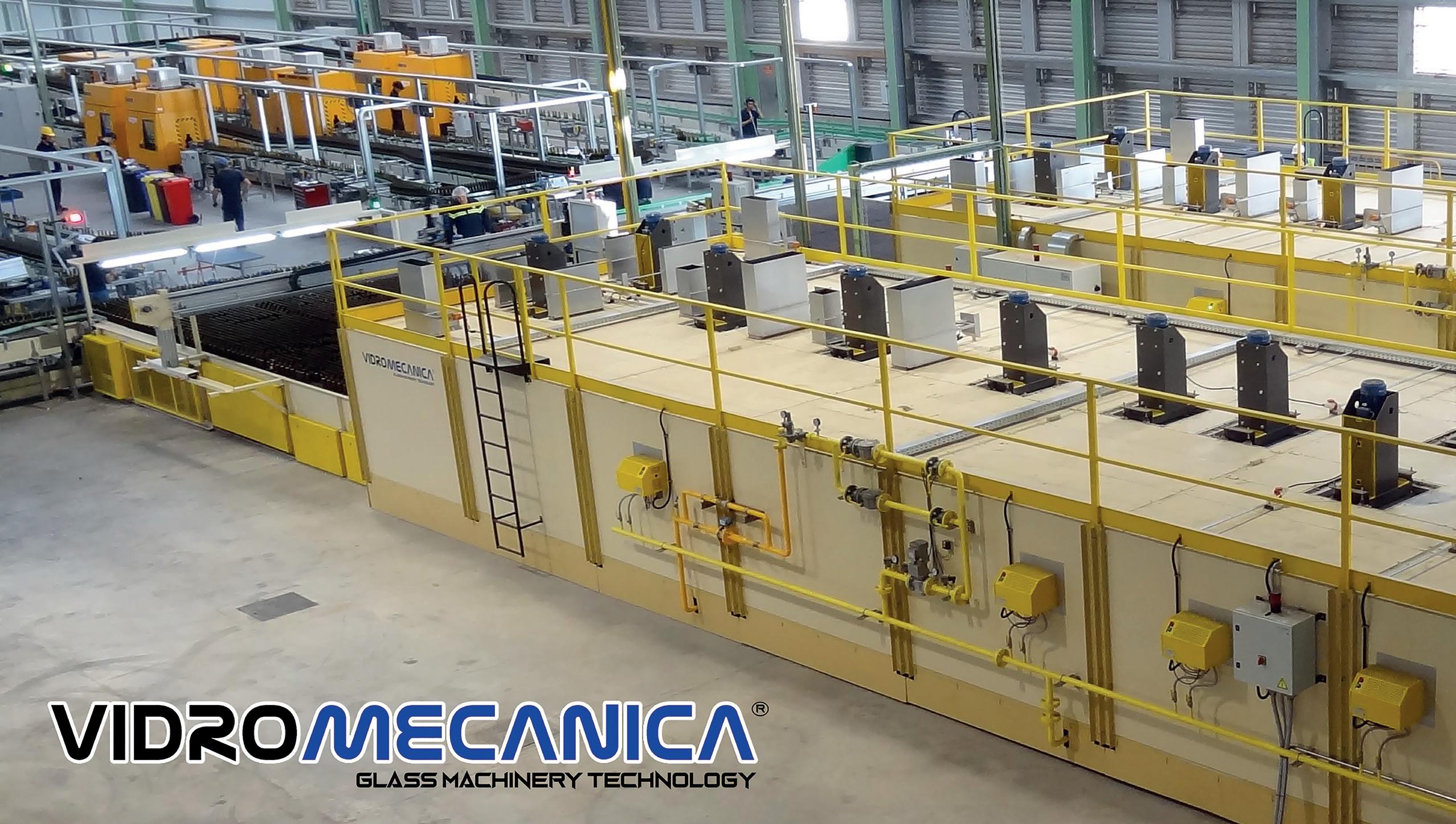
4 minute read
Annealing: Vidromecanica
� Vidromecanica’s annealing lehrs.
Improved the annealing lehrs cycle
Annealing is an important element of the glass-making process which is more complex than it may first appear. Precisely controlled cooling is required during annealing until a sufficient strain point is reached, reports Vitor Maia.*
Glass is described as a mineral product obtained by a melting process that cools without crystallisation and finally takes a solid state.
This definition provides the basis of the annealing process.
Every glass type (soda lime, borosilicate, etc.) is characterised by a different batch composition and consequently, a different temperature-dependent viscosity and expansion coefficient.
During melting, the batch passes continuously from a solid to a liquid state.
At forming it is brought back to a solid, passing the various ‘plastic’ stages and characterised by different viscosities.
These define the characteristic points of glass annealing, such as working, softening, annealing and strain points and annealing range (the temperatures between softening, annealing and strain points). Through knowledge of the annealing range, temperature limits for each stage have been established (Fig 1).
Permanent Stresses
There are two types of residual stress: Permanent and temporary. Annealing is in fact a cooling process.
Glass has poor temperature conductivity and although this property can be advantageous in some instances, it is an inconvenience in annealing.
To explain the origins of stress, consider that glass is made up of a series of distinct layers, lying parallel to the surface. Heat loss from the glass depends on the transfer of heat from layers in the body of the glass to those at the surface.
These layers are interdependent and in different states of expansion. As the external surface cools faster, it reaches its final shape while the centre is still in expansion.
All the molecules are intimately bound and their reciprocal action will create compression stresses once the inner layers have cooled and contracted.


� Flexibility is key to getting the right annealing lehr for Vidromecanica.
There is a necessary balance to maintain between compressive and tensile stresses. Imbalances create varying degrees of destruction in the glass thickness but if cooling is achieved sufficiently slowly, the layers will not be submitted to disturbance and stress generation will be avoided.
All stresses created at this point remain permanent and annealing is important because mechanical and thermal resistance are conditioned by it.
Temporary Stresses
When being cooled below strain point, glass can still be submitted to thermal influences creating temporary stresses and distortions that disappear slowly.
However, unless cooling is controlled, unbalanced stress levels could lead to breakages. Of course, controlled and strong cooling to generate high stresses makes toughening desirable in some instances. Increasing the compression stress on the surface gives the glass high mechanical and thermal resistance.
Annealing Curve
Passing through the tunnel of a continuous annealing lehr, glass follows a fixed temperature gradient that is necessary to produce the desired level of stress.
Glass must be reheated or cooled to assure homogeneity above the annealing point. The amount of time glass is maintained at this temperature is determined by time-thickness calculations.
Precisely controlled cooling is required during the annealing phase until the strain point is reached.
The cooling gradient is given by calculations depending on glass thickness and type. Finally controlled, fast cooling is necessary to bring the glass to ambient temperature. This process must also be maintained within calculated tolerances to avoid breakages resulting from temporary stresses (Fig 2).
Conclusions
Annealing is an important element of the glass-making process more complex than it may first appears.
Consequently, thorough knowledge of the process is becoming increasingly necessary. A number of scientists have developed theories and established rules that are relatively easy to use, including Adams and Williams (widely used), Shand (Corning Glass); Owens (the most widely used and easy-to-use curves); and Redstone and Stanworth (mainly used for optical glass).
Neutral annealing, avoiding the creation of stresses, is not necessarily the ultimate goal to attain.
In certain instances, the introduction of controlled stresses to the glass can be advantageous. Design flexibility has certainly been an important requirement for lehr builders such as Vidromecanica over the last three decades, providing customers with readily adjustable heating and cooling equipment.
Vidromecanica manufactures thermal equipment (for annealing, decorating and toughening); equipment for coating treatment (hot and cold end coating) and cullet recycling equipment.
Development, design and manufacture of machinery, development of control systems, control panel construction and software provision for the production lines are handed by the company’s inhouse specialists.
With glass machinery solutions for many applications of the glass industry, equipment and systems from Vidromecanica are used in the glass container, tableware and technical glass sectors (Fig 3 and Fig 4). �
*Technical Director, Vidromecanica, Marinha Grande, Portugal www.vidromecanica.com; Email: vidromecanica@vidromecanica.com










